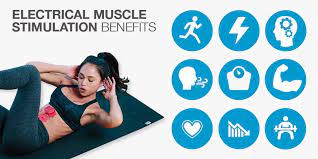Since the time of the ancient Egyptians, who employed fish to generate electrical currents to cure various diseases, electrical stimulation has been used in therapy. Four thousand years later, the therapist has access to a wide range of electrical stimulation tools. So, this post will examine several aspects of the fantastic EMS machine while focusing on the expanding field of electrical muscle stimulation (EMS).
The wide range of techniques, and names, such as Transcutaneous Electrical Stimulation (TES), Functional Electrical Therapy (FET), Functional Electrical Stimulation (FES), and Neuromuscular Electrical Stimulation, is the first thing you observe when you research electrical muscle stimulation. However, all the solutions listed above rely on the same physiological principles and share the same fundamental concepts to be effective.
What Exactly Is Electrical Muscle Stimulation (EMS)?
As part of the procedure, an electrical current is often applied on the skin’s surface using sticky or rubber electrodes placed on the skin close to the muscles that need to be stimulated to cause a muscular contraction. The electric charge enters the tissues and depolarises an undamaged motor neuron, which then transmits the impulse to the muscle group through synaptic connection to the motor end plates, causing this muscular contraction.
The resulting muscle contraction might range from a little twitch to one strong enough to move the joint physiologically. The clinician’s use of the accessible electrical stimulation parameters leads to this modification of a generated muscle contraction. Meanwhile, the settings are similar for most EMS units, while the amplitude, frequency, and pulse span are the common parameters. And to use EMS effectively, the therapist must have confidence in manipulating these parameters.
How Does EMS Feel?
Some say they have twitching muscles, dull tingling, or slight pricking sensations, and most of the time, these sensations only last during the therapy session, although occasionally, patients report feeling them up to 30 minutes later.
Benefits of Using EMS Machine
Muscular Blood Flow Is Enhanced: EMS has been demonstrated to enhance blood flow to muscle tissues (typically performed at lower frequencies). The muscle operates as a pump to boost oxygen-rich blood circulation into the muscular core and to help remove metabolites from the muscle because of the relaxation and contraction cycles of the electric signals.
Lessening of Muscle Pain: According to several studies, athletes who followed EMS protocols experienced less muscle discomfort overall than those who did not. In addition, athletes who experience less pain (real or perceived) are frequently able to exercise harder and feel better healed before subsequent training sessions, which improves performance outcomes.
Improved Physical Power and Strength: While an EMS machine cannot replace power and strength conditioning, it has boosted athletes’ muscular contraction frequencies and strength. This can also be helpful for those going through the rehabilitation process because it is a fantastic technique to retrain muscle fibres, improve strength without putting a lot of external load on them, and stimulate muscle fibres.
Enhancing Psychological Recovery: EMS has been demonstrated to enhance an athlete’s psychological rehabilitation and perceived recovery. This is crucial because a recovered athlete will frequently be able to train hard and produce better training results.
The EMS has been pivotal in muscle recovery and physical performance enhancement for users since its inception. But remember to consult your doctor before buying a personal EMS device, and rest assured that you will be in top physical shape in no time.
